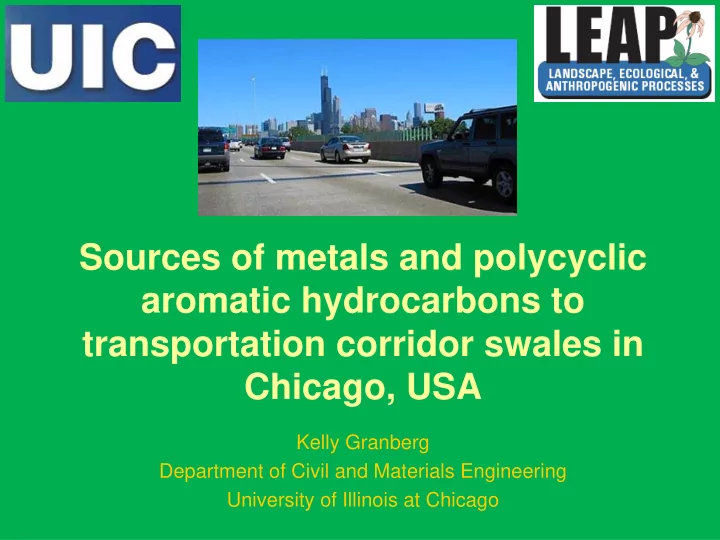

Sources of metals and polycyclic aromatic hydrocarbons to transportation corridor swales in Chicago, USA Kelly Granberg Department of Civil and Materials Engineering University of Illinois at Chicago
Context and justification Contamination: Links to complex environmental and societal problems including degradation of water resources , spread of invasive species, climate change, human health… Sources of contamination can tell – Which releases are dominant – What engineering or policy controls could be useful to reduce pollution
Context and justification Chicago : Highly urbanized yet retains natural features – Large network of interstate highways and waterways. – Model city for LEAP (Landscape Ecological & Anthropogenic Processes) program at UIC. LEAP student led research project: “The role of contamination on poison hemlock’s ( Conium maculatum ) expansion into a disturbed urban landscape”
Research Project Goals Determine if: 1. Soil in transportation corridors in Chicago contain elevated levels of common urban contaminants heavy metals & polycyclic aromatic hydrocarbons (PAHs). 2. Soil contamination can be apportioned to specific transportation, bio-solid, and/or industrial sources, with the largest contribution expected from transportation sources.
Methodology 1: Sample collection and analysis Twenty eight soil cores taken at nine poison hemlock patches. Samples characterized for physical/chemical soil parameters & analyzed for 20 PAHs and 20 heavy metals.
PAH and metal levels in roadside soil samples Sample collection & analysis
Methodology 2: Source apportionment (SA) analysis ‘Receptor’-oriented approach to determine contributions of various pollution sources to a location of interest. 1. Indicator ratios - simple method to infer general PAH sources Petrogenic Combustion Mixed Combustion Petroleum Petroleum Combustion Soil samples sources Biosolid samples 0.8 0.7 Grass, wood Grass, wood 0.7 0.6 & coal combustion & coal combustion 0.6 0.5 Inp/Inp+BghiP FlA/FlA+Pyr 0.5 0.4 Petroleum Petroleum 0.4 combustion 0.3 combustion 0.3 0.2 0.2 Petroleum 0.1 Petroleum 0.1 0 0 0 0.2 0.4 0.6 0.8 1 0 0.2 0.4 0.6 Ant/Ant+Phe BaA/BaA+Chr
Source Apportionment continued: 2 - Factor Analysis Principal Component Positive Matrix Analysis (PCA) Factorization (PMF) 1. Sources of pollution? 2. Loading of each source to each receptor? m number of compounds, n number of samples, p number of sources
Signature source profiles: Source ‘fingerprints’ Highway dust is composite of Christensen and Bzdusek, 2005 & Murakami et al. 2005, all others were compiled from Li et al. 2003.
Positive Matrix Factorization Result Two source profile plots for PAHs and metals Source one has a strong diesel Source one possible traffic signature. combustion source. Source two has elevated coke Source two..? oven or weathered biosolids signature.
Planned research activity Build library of metal and PAH signature source profiles from raw data. — Quantitatively measure similarity between PMF and signature profiles Subject data to other SA methods for comparison. — US EPA PMF 2.0, Chemical Mass Balance, Principal Component Analysis with multiple linear regression Apply SA to other urban receptor sites — PAHs, PBDEs, black carbon in sludge and PAHs in IL River sedim ent Anthropogenic impacts to urban greenspaces: sources and fate of transportation and wastewater related contaminants to the Chicago region
Significance & limitations of SA for developing countries Growing contamination and health risk due to rapid urbanization & increased energy demands. SA methods relatively easy to replicate, inexpensive to use, and requires moderate information to model. Show where to focus pollution reduction efforts, strengthen local level management where However: not all contaminants and all matrices work equally well with all methods, lack of signature source profiles, knowledge & training; most informative in conjunction with other methods.
Thank you WWW-YES committee and participants! Acknowledgments: Acknowledgments: K. Rockne, E. Christensen, A. Li, J. Ison, P. Gulezian K. Rockne, E. Christensen, A. Li, J. Ison, P. Gulezian Funding: Funding: Chicago Wilderness Small Grant to J. I. Ison, K. J. Chicago Wilderness Small Grant to J. I. Ison, K. J. Granberg, and P. Z. Gulezian; National Science Granberg, and P. Z. Gulezian; National Science Foundation IGERT Grant DGE 0549245 to M. V. Ashley Foundation IGERT Grant DGE 0549245 to M. V. Ashley
Principal Component Analysis Result Two factor loading plots for PAHs and metals No clear sources emerge from Vanadium may indicate a factoring out low & high traffic source, but the other molecular weight PAHs is unknown
Recommend
More recommend